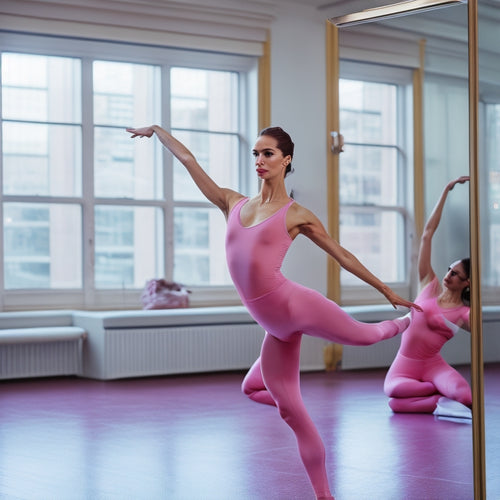Library of Congress Unveils Historical Dance Treasures
Share
The Library of Congress has revealed a treasure trove of historical dance treasures, offering a fascinating glimpse into the social norms, cultural values, and entertainment preferences of the past. The Dance Instruction Manual Collection serves as a window into the past, exposing cultural dances and traditional steps that showcase a rich tapestry of cultural heritage. This repository provides insights into dance evolution, from 19th-century waltzes to traditional folk dances, and unearths hidden gems that shed light on past society intricacies. As we explore these historical dance practices, we may yet uncover even more secrets hidden within the archives, waiting to be discovered.
Key Takeaways
• The Library of Congress's Dance Instruction Manual Collection showcases historical dance practices, revealing social norms, cultural values, and entertainment preferences.
• The collection serves as a window into the past, featuring a rich tapestry of cultural heritage and dance evolution from 19th-century waltzes to traditional folk dances.
• The archives provide a glimpse into social etiquette, cultural norms, and artistic expressions of bygone eras, unearthing hidden gems that reveal past society intricacies.
• The Dance Instruction Manual Collection offers detailed descriptions of historical dances, including the Sir Roger de Coverley, and features forgotten dance traditions waiting to be rediscovered.
• Researchers can explore the collection to revive cultural heritage of bygone eras, unveiling snippets of social history and traditional dance movements.
Historical Dance Practices Revealed
Exploring the Library of Congress's Dance Instruction Manual Collection, one uncovers a treasure trove of historical dance practices that reveal the intricacies of bygone eras, offering a fascinating glimpse into the social norms, cultural values, and entertainment preferences of the past.
This vast repository of dance instruction manuals serves as a window into the past, unearthing cultural dances and rediscovering traditional steps that have shaped the course of dance history. By investigating these manuals, researchers and enthusiasts alike can gain a deeper understanding of the evolution of dance, from the elegant waltzes of the 19th century to the vibrant rhythms of traditional folk dances.
As we immerse ourselves further into the collection, we find a rich tapestry of cultural heritage, where the boundaries of time and space dissolve, and the beauty of dance is revealed in all its glory.
Dance Treasures From the Archives
Within the Library of Congress's vast archival repository, a veritable treasure trove of historical dance treasures awaits discovery, offering a fascinating glimpse into the social etiquette, cultural norms, and artistic expressions of bygone eras.
By unearthing dance history, researchers can uncover hidden gems that reveal the intricacies of past societies. The Library's Dance Instruction Manual Collection, for instance, provides valuable insights into historical dance practices, with detailed descriptions of various dances, including the Sir Roger de Coverley, a popular dance featured in Charles Dickens' A Christmas Carol.
These archival treasures offer a unique window into the past, allowing us to appreciate the evolution of dance as an art form and its significance in shaping cultural identity.
Uncovering Forgotten Dance Traditions
Through the meticulous excavation of historical archives, researchers can explore forgotten dance traditions, reviving the cultural heritage of bygone eras. In this pursuit, the Library of Congress Dance Instruction Manual Collection serves as a treasure trove, offering a glimpse into historical dance practices.
By rediscovering traditional dances, we can uncover the nuances of forgotten cultural movements, revealing the intricate tapestry of social history. As we investigate the archives, we find snippets of social history, from dance cards to descriptions of Sir Roger de Coverley, a dance featured in Charles Dickens' A Christmas Carol.
Frequently Asked Questions
What Is the Significance of Dance Cards in Social History?
Dance cards, or carnets de bals, served as a tangible representation of social etiquette, governing cultural rituals in 19th-century high society, where a lady's acceptance of a gentleman's invitation was a delicate dance of propriety and respectability.
How Did Sir Roger De Coverley Dance Become Popular?
In the Regency Era, Sir Roger de Coverley's popularity soared as a symbol of courtly manners, its intricate steps and joyful energy enchanting aristocrats and commoners alike, rendering it an indispensable staple of high-society gatherings.
Are Dance Instruction Manuals Available for Public Access?
Yes, dance instruction manuals are available for public access through digital archives, offering a treasure trove of historical dance practices in the public domain, awaiting discovery and exploration by enthusiasts and scholars alike.
Can Historical Dance Practices Be Learned From Literary Works?
Through literary choreography, dance historiography unravels, revealing historical dance practices embedded in literary works, such as Sir Roger de Coverley in Dickens' A Christmas Carol, offering a unique window into the past, awaiting discovery and interpretation.
How Do Librarians Contribute to Preserving Dance Heritage?
'As custodians of cultural memory, librarians play an essential role in preserving dance heritage through meticulous digital archiving, ensuring the world's cultural treasures remain accessible, while safeguarding the nuances of historical dance practices for future generations.'
Related Posts
-

3 Essential Marketing Tips for Dance Makeup Artists
To shine online and attract new clients, you'll need a solid marketing strategy. First, boost your online visibility ...
-

3 Ways to Monetize Your Dance Expertise Online
You can harness your dance expertise into a lucrative online business by leveraging your skills in three key ways. Yo...
-

Dance Practice Wear Picks for Maximum Comfort and Performance
When choosing dance practice wear, you want gear that optimizes comfort and performance. Opt for moisture-wicking fab...


